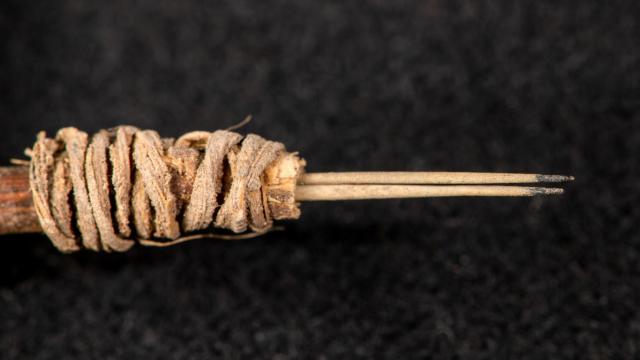A 2,000-year-old wooden implement with black-tipped cactus spines is now the oldest example of a tattoo tool in western North America, a discovery that’s shedding important new light on this ancient practice. Incredibly, the relic might have never been discovered had it not been for an inventory check.
The tool, discovered by anthropology Ph.D. candidate Andrew Gillreath‑Brown from Washington State University, dates back to the Ancestral Pueblo people of southeast Utah, who lived 2,000 years ago during the Basketmaker II period (around 500 BCE to 500 CE). The 10cm-long device, created over 1,400 years prior to the arrival of European colonists, was made from a sumac tree stem, yucca leaf strips, and the sharp spines of a prickly pear cactus, the tips of which were stained in black. The discovery, chronicled in a new study published this week in the Journal of Archaeological Science: Reports, is more than a thousand years older than other early evidence for tattooing in western North America.
Tattooing as a practice has very ancient roots. Ancient Egyptians were 61 tattoos found on the mummified remains of Ötzi The Iceman. Post-Columbian indigenous North Americans also engaged in the practice, but evidence dating further back in time is severely lacking.
Unlike the mummies of ancient Egypt and the ice-preserved remains of Ötzi, mummies are hard to come by in North America. And because soft tissue doesn’t preserve very well, any direct traces of tattooing have been obliterated.
“[T]attoos have not yet been identified on any precontact mummified remains and few tattoo tools have been identified in the archaeological record,” the authors noted in the new study. “Thus, the full temporal extent and material culture of Native American tattoo practices…are poorly understood.”
Prior to the new discovery, the oldest evidence of tattooing in western North America came from bundled cactus spine tattoo tools found in Arizona and New Mexico dating back to between 920 to 740 years ago. The new discovery pushes tattooing in western North America back another 1,000 years.
The item was uncovered at Utah’s Turkey Pen archaeological site in 1972, but it remained forgotten and unidentified for 45 years. Gillreath‑Brown stumbled upon the artifact in 2017 while inventorying and re-evaluating archaeological items from Turkey Pen, which were kept at a Washington State University storage room for decades. When he saw the relic, Gillreath‑Brown was struck by how much it looked like the tattooing tools found in Arizona and New Mexico.
“When I first pulled it out of the museum box and realised what it might have been I got really excited,” said Gillreath‑Brown in a press release. “The residue staining from tattoo pigments on the tip was what immediately piqued my interest as being possibly a tattoo tool.”
The tattoo tool itself wasn’t directly dated, but the researchers analysed organic materials found in the sediment where the tool was found, allowing for carbon dating.
“Because the stratigraphy of these layers was so meticulously established, the authors were able to define a narrow window of possible ages for the tattoo tool,” Alia Lesnek, a Ph.D. Candidate at the University at Buffalo who wasn’t involved in the new study, told Gizmodo. “In my opinion, they did a fine job.”
Gillreath‑Brown recruited study co-author Aaron Deter‑Wolf, an expert on ancient tattoos from the Tennessee Division of Archaeology in Nashville, to help with the analysis of the artifact itself. The team used various instruments to study the black tips of the cactus spines, including a scanning electron microscope and X-ray fluorescence. Results showed that the black stains were a pigment made from carbon—a common and easily accessible material for tattooing.
Not content to leave it at that, the team embarked on some experimental archaeology. A functional replica of the device was made using similar materials. For the ink, the researchers created a black slurry made from charcoal and water. In a series of experiments, the device was used to successfully tattoo fresh pig skin, which the researchers got at a local grocery store.
James D. Norris, an experimental archaeologist from Kent State University who wasn’t affiliated with the study, said the relic is “without a doubt” a tool used for tattooing. Previously, scientists had to make inferences about the existence of the practice in ancient North America, such as studying depictions of tattooing on figurines and pottery, but “now we have concrete evidence backed with experimental archaeology that tattooing was done back then,” he told Gizmodo.
As for the reason behind the practice, Norris said we can only speculate.
“Tattooing was likely done for many different reasons,” he explained, “It could have been done for spiritual reasons, or a way to convey social status. It may even have been seen as a way into the afterlife.”
Interestingly, the tattoos on Ötzi The Iceman were strategically placed around the Bronze Age European’s injuries and sore spots, likely for therapeutic reasons. It’s possible the Ancestral Pueblo people did it for similar reasons, but as Norris pointed out, we can only guess. That said, Norris, who worked as a tattoo artist for eight years and has many tattoos himself, said some people use tattooing today for similar reasons, saying “it’s like therapy to them.”
The new discovery is shedding light on the past, but as Norris pointed out, it carries implications to modern culture as well.
“It’s good to see how rich the history of tattooing really is and how much it really meant to our ancient ancestors,” he told Gizmodo. “If we can better understand why they were tattooing back then, it might become more socially accepted now.”
